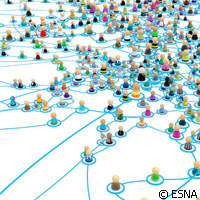Europeans making smart device communication even easier
Researchers from the ESNA ('European sensor network architecture') project are making communication lines easier for people. Using a standard architecture to facilitate smart device communications, ranging from environmental controls at home to domestic appliances and sophisticated control equipment in manufacturing facilities, the ESNA partners have developed their flexible framework for business-oriented wireless-sensor network applications. ESNA is part of the EUREKA ITEA (Information Technology for European Advancement) software cluster; EUREKA is the European platform for research and development (R&D). ESNA provides better networking without burning big holes in pockets. The system is based on cheap wireless sensors in various business applications including energy-efficient environmental controls. To date, the project partners have demonstrated a series of implementations leading to real applications, namely energy monitoring and management in buildings, industrial process control and precision agriculture. The range of intelligent machines is growing. Unconventional multimedia systems, along with household washing machines and heating and ventilation controls are joining the list. Our homes are becoming hubs for such innovation; various devices are connected and provide us with intensified control over our daily comfort and safety. With the Internet finding a niche in both our homes and at work, control and interactivity is intensified through the so-called 'Internet of things', from factory production to modern agriculture. The Internet of things got a huge boost from the development of wireless networks facilitating the interconnection of all types of sensors using radio communications. According to the researchers, the devices can be fitted into almost any device because their size is so small. Another plus is that they can be fitted at lower costs. Sources say that despite the fact that these types of devices are produced in Asia, Europeans are very interested in using such components for wireless sensor networks. Power cabling becomes a thing of the past when battery power enters the picture. Another advantage is that the devices are multifunctional: nodes can be equipped with various sensor capabilities including humidity, temperature, radiation, movement, gases and light. It should be noted that if one node fails, the network automatically 'rearranges' itself to ensure it runs smoothly. 'We discussed wireless sensor network applications at an ITEA brokerage event in Barcelona in 2005,' says project leader Olle Olsson of the Swedish Institute of Computer Science (SICS). 'We saw the way EUREKA operated was good, because it enabled the matching of product and application-oriented technology development in the same project. The result was a project that combined technology "geeks" and organisations keen to supply technologies for specific markets. We also had end users interested in using rather than selling technologies.' Mr Olsson says they developed novel things. 'We worked on a standards-compliant generic platform based on the emerging IPV6 Internet standard, developing the world's smallest implementation of IPV6 in terms of lines of code,' he says. 'Overall, we have developed a strong European lead in wireless sensor networks in a field which is still emerging globally.'For more information, please visit:ESNA:http://www.sics.se/esna/index.php?option=com_frontpage&Itemid=1EUREKA:http://www.eurekanetwork.org/
Countries
Sweden



